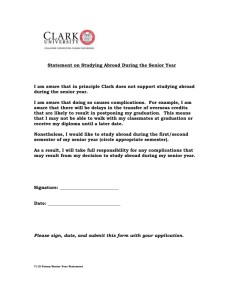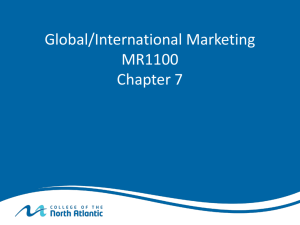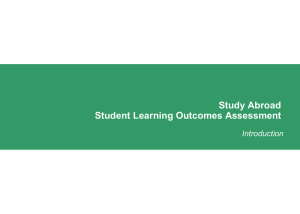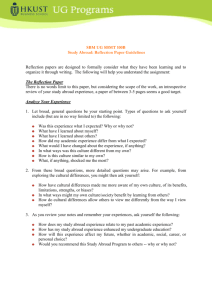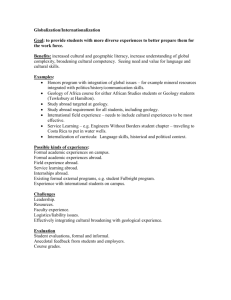OUTCOME OF AUDIT: (1) Interactive global map which highlights areas of the globe in which we have Hope
advertisement
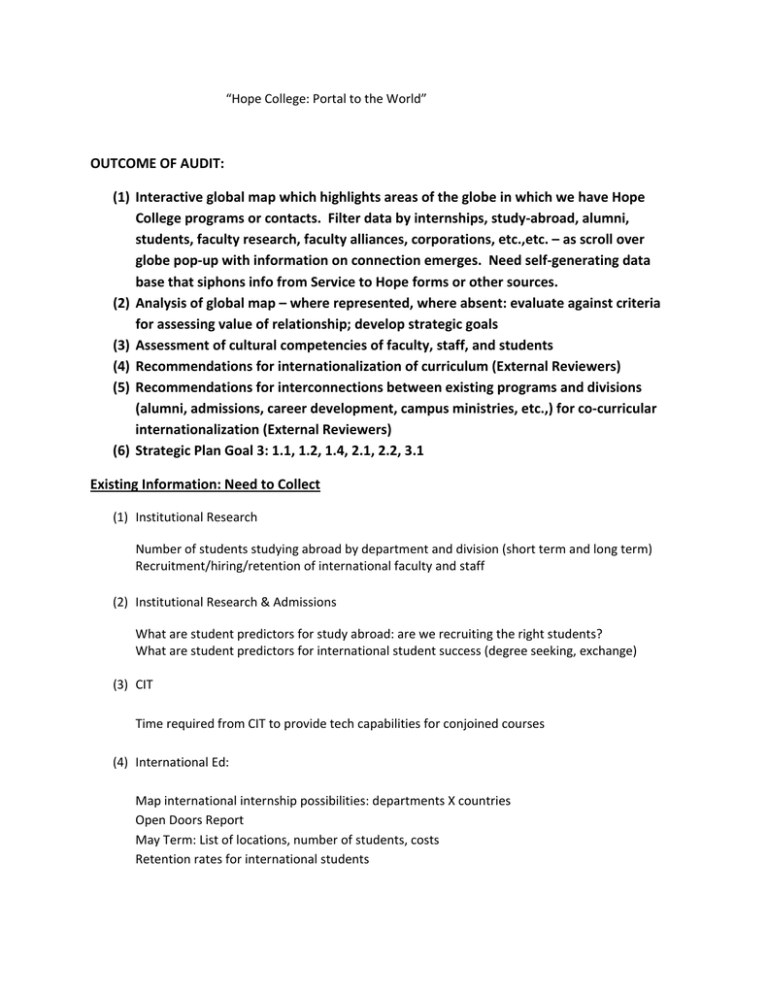
“Hope College: Portal to the World” OUTCOME OF AUDIT: (1) Interactive global map which highlights areas of the globe in which we have Hope College programs or contacts. Filter data by internships, study‐abroad, alumni, students, faculty research, faculty alliances, corporations, etc.,etc. – as scroll over globe pop‐up with information on connection emerges. Need self‐generating data base that siphons info from Service to Hope forms or other sources. (2) Analysis of global map – where represented, where absent: evaluate against criteria for assessing value of relationship; develop strategic goals (3) Assessment of cultural competencies of faculty, staff, and students (4) Recommendations for internationalization of curriculum (External Reviewers) (5) Recommendations for interconnections between existing programs and divisions (alumni, admissions, career development, campus ministries, etc.,) for co‐curricular internationalization (External Reviewers) (6) Strategic Plan Goal 3: 1.1, 1.2, 1.4, 2.1, 2.2, 3.1 Existing Information: Need to Collect (1) Institutional Research Number of students studying abroad by department and division (short term and long term) Recruitment/hiring/retention of international faculty and staff (2) Institutional Research & Admissions What are student predictors for study abroad: are we recruiting the right students? What are student predictors for international student success (degree seeking, exchange) (3) CIT Time required from CIT to provide tech capabilities for conjoined courses (4) International Ed: Map international internship possibilities: departments X countries Open Doors Report May Term: List of locations, number of students, costs Retention rates for international students (5) Alumni Relations: Identify connections for Fulbright, Peace Corps, GAP Identify UN and/or World Health connections NGO post‐grads – where are they? (6) International Ed, Dean of Multicultural & International, Alumni, Advancement List of constituents abroad – name, contact, Hope contact, connection, yrs Comprehensive list of glocal potential partners: Dean, Alumni, Advancement, CFL, DEMA… (7) Dean List of partner institutions – status of relationship (MOU), goals, fields of study offered, exchanges (# fac/staff/students) Information that can be Collected Internally (1) Faculty survey: a. Areas of international expertise b. Areas of international interest c. Areas of international research (topic and/or collaboration) d. Research collaborative or partnership: 1:1 faculty research, hosting international scholars, visiting professorship at international institution, formal memo of understanding e. Nature of interaction with international students f. Interest in international research: attending seminars/conferences on international topics related to your discipline; faculty exchange in another country; short‐term research or curriculum development projects or service learning projects in other countries g. Existing international partnerships/connections (industry, higher ed, foundations, govt, ngo) h. Existing international courses? Level of content? i. Interest in development of international course j. Existing relationships with international partners (institutions, corporations, individuals) k. Offer an existing May Term? Academic preparation for May Term required? Continuity of May Term offering (# of years) and development of back‐up faculty to offer program? Contacts with institutions, corporations or individuals? l. Have you or are you currently teaching an international conjoined course? With whom? How often is the course offered? m. Evidence of faculty development of international competencies? n. Fac experience in online teaching? Faculty development in online teaching? o. Faculty experience in collaborative teaching? Faculty development in collaborative teaching? p. q. r. s. t. u. Faculty experience in service‐learning? What are your technology/space needs for teaching international courses? Hindrances to developing international courses? Connections with local international local communities? Motivation/perception of importance of international experience? Perceptions of resources needed and their relative importance: information resources, global knowledge, lacking disciplinary connections, global learning outcomes assistance, course materials, faculty development, grant funds for travel abroad, speakers for courses. v. Sufficient co‐curr activities on campus w. Hope culture pays sufficient attention to global and international affairs x. How frequently engage students in conversations about multicultural and international events/affairs or issues? (2) Student survey: a. Areas of international experience (courses, study‐abroad, co‐curricular) b. Areas of international interest c. Interest and likelihood of study abroad (long‐term, short‐term) d. Hindrances to studying abroad (who isn’t studying abroad and why) e. Motivation for global learning (courses, co‐curricular) f. What are the technology needs for increasing your global exposure? g. International student experience (realization of expectations) h. Sufficient co‐curr activities on campus i. Hope culture pays sufficient attention to global and international affairs j. (3) Staff survey a. Areas of international expertise b. Areas of international interest c. Existing international partnerships/connections (industry, higher ed, foundations, govt, ngo) d. Evidence of professional development of international competencies? e. Sufficient co‐curr activities on campus f. Hope culture pays sufficient attention to global and international affairs g. How frequently engage students in conversations about multicultural and international events/affairs or issues? (4) Alumni Graduate Survey a. Outcomes/applications of international education experiences (on‐ and off‐campus) (5) Program Audit: qualitative interview or focus group with program directors of international programs to assess quality and effectiveness, best practices, etc., to build model for program development in other parts of the world Recommendations or Hindrances (1) Advising: a. When and where to do off‐campus studies b. Promotion of study abroad during advising/registration c. Current advising has disciplinary focus as opposed to 4‐yr development model (2) Departments a. Policy on study abroad credit b. Information on department websites c. Heavy course requirements in some majors (esp BS majors) preclude study abroad d. How do we prioritize and capitalize on faculty global expertise/knowledge before global faculty get sucked into GE or department teaching loads e. Is disciplinary focus hindering opportunities for global learning, interdisciplinary learning, innovative pedagogy f. NAS summer research schedule hindrance to short‐term study abroad – change to 8 wks g. NAS consider B.A. degrees providing more flexibility for liberal arts and global learning h. Major/Minor structure is hindrance – consider IDS programs/certificates (64% institutions offer international global tracks, certificates or concentrations – most often in business, humanities and social sciences) i. Department approval for international internships j. Make connections between global learning and pre‐professional programs k. Pressure to fill on‐campus courses decreases motivation to promote off‐campus programs (3) General Education a. Review requirements to provide more flexibility for study abroad (4) May Terms a. Erratic offerings – develop plan for coverage and development of faculty to teach (5) Faculty Development a. How do we incentivize and develop faculty in new directions? ‐international teach/research part of service to hope, tenure & promotion b. Explore question of ‘how does one become global citizen’ c. Development of faculty global competencies d. Faculty development in online course development e. IES program for faculty to study and teach at other campuses f. Team‐taught courses in which exchange faculty for ½ semester g. Funding to present or research abroad; staff development abroad h. Workshops on internationalizing the curr, global learning assessments i. Opportunities for faculty to improve foreign language skills j. Workshops on tech to enhance international dimension of courses (6) Global Courses/Content Development a. Explore UN courses, New University online courses b. Explore Peace Corps certification c. How do we disseminate (7) Structural & resource challenges and opportunities a. Decision‐making empowerment, reporting structure, b. Already overextended – asked to take on more work c. Interdisciplinary teaching resources d. Recognition of faculty global teaching, pedagogy, scholarship e. What is profit margin on study abroad programs, short‐term study abroad? Is there a way to make these programs more affordable for students? (8) Develop technology resources necessary to implement global curriculum a. Designated spaces for skype b. Investigate platforms – e.g, Blackboard for group online forums c. Increased bandwidth d. Long distance learning technology e. Design new Student Center with global café capabilities f. Provide international news/broadcasts g. What does it mean to be globally‐minded with technology? h. Does CIT have a strategic plan re global access? Need integrated and intentional plan for developing infrastructure to support global learning. i. What would it take to offer connections for anatomy lab, arts/dance tech j. How do we globalize Mellon Scholars program? (9) Career Development a. International internship opportunities & employment abroad b. Promotion of Fulbright, Peace Corps, GAP c. Connect with International Alumni Network (10) Advancement, Alumni, Admissions, Faculty, Career Dev., through Dean a. Leverage constituents abroad for internships, site visits, jobs, admissions, college fairs, admissions, events, contacts with other constituents, personal giving, access to others of affluence b. Leverage constituents through developing contacts list from students studying abroad, faculty on tour, advancement visits, mail, regional events, networking c. International alumni advisory teams associated with academic programs d. MOU and time‐line goals for international partnerships? (11) Student Development & Campus Ministries a. Major artists/concerts/lecture series b. World Christian Lecture Series c. Veritas d. International and domestic student buddy systems or l Goals/Strategies Needed (1) May Term strategy for evaluating where short‐term courses offered (2) Does Student Development have global goals? a. Global connections to residential life education, student groups, student leader training, Bridge, arts/concerts, b. Development of cultural proficiency with/in student life initiatives as well as cultural proficiency of staff (3) Hiring/recruiting/retention a. HR b. Provost c. Assessment of competencies in search process? (4) Campus Ministries – global goals? Assessment: (1) Develop and implement common cultural competence assessment tool a. May Term/June Term Short Term Study Abroad i. Student outcomes assessment b. Conjoined Courses i. Student outcomes assessment c. Semester Abroad Programs i. Student outcomes assessment d. Global Exposure measurement e. Competencies assessment (as well as self‐report) (2) Develop and implement rubric for assessment of global partnerships (3) Identify curr/co‐curr shared learning outcomes STEPS 1. 2. 3. 4. 5. 6. 7. $ and Human Resources Needed Write GLCA Grant Proposal Design surveys & collect data for self‐study Invest in Assessment Development (1 above) Develop Rubric (2 above) Create comprehensive self‐study report w/ data External Review S16 Develop goals
